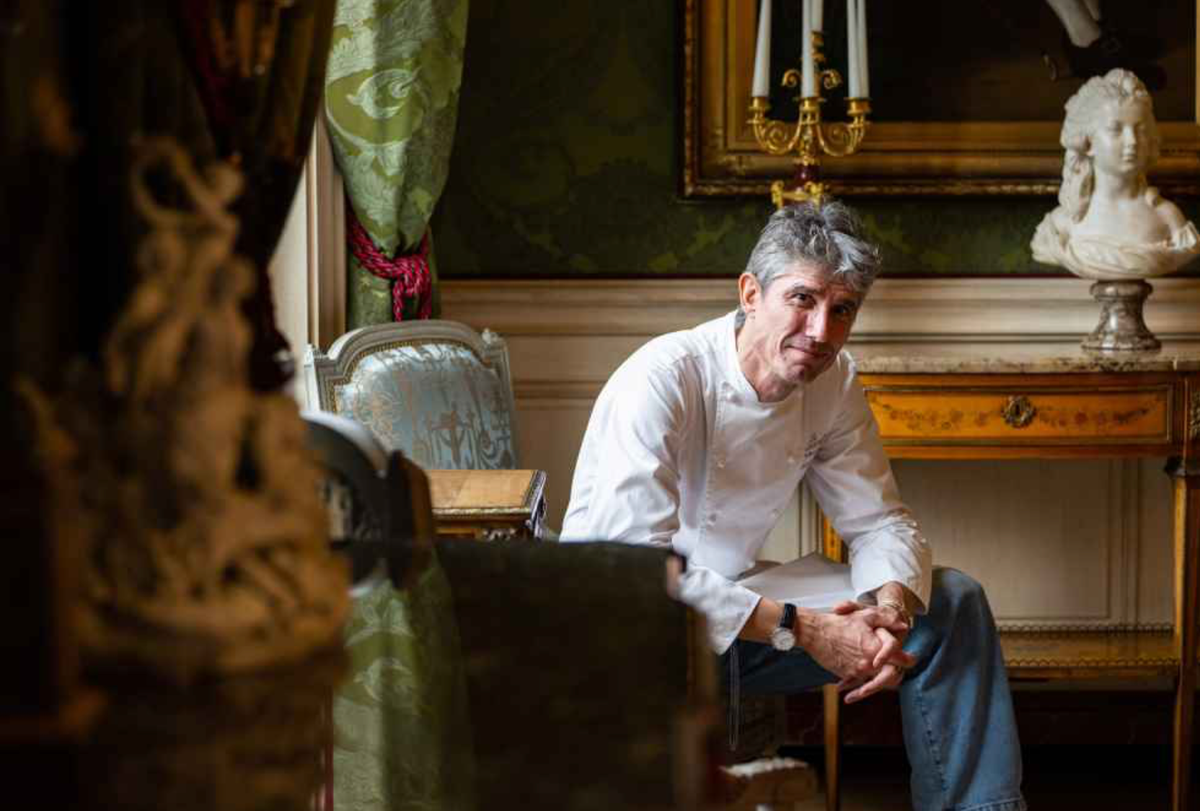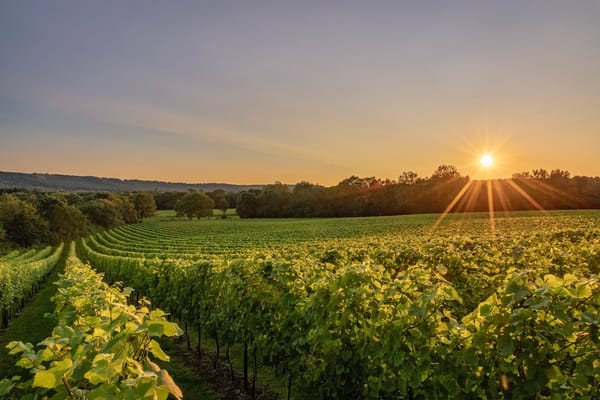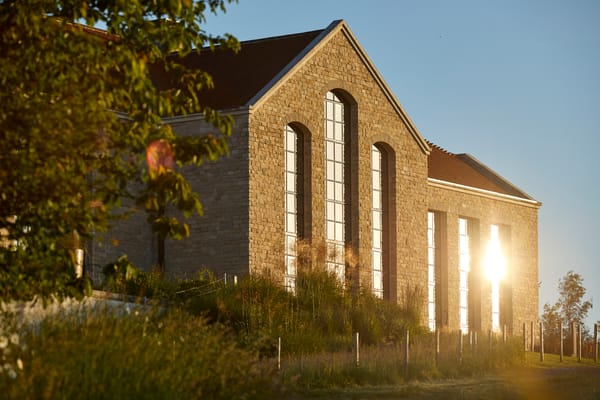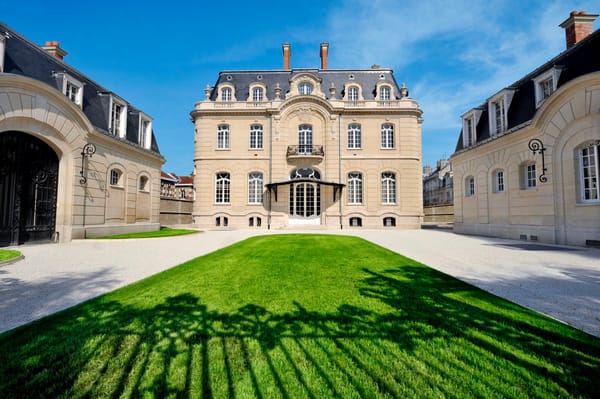Le Clarence - 2 Michelin Star Excellence in Paris

Le Clarence, nestled in the heart of Paris, a stone’s throw from the recently renovated Grand Palais, is full of both old-world charm and modern elegance. Set within a grand mansion just steps away from the Champs-Élysées, this two-Michelin-starred restaurant is complete with a wine store that holds bottles of France’s finest wines from the best vintages. The mansion and restaurant are owned by Domaine Clarence Dillon, the family-owned company behind Château Haut-Brion. This alone sets the tone perfectly for what you might expect.
Le Clarence’s setting in the Hôtel Dillon is a blend of stately grandeur and intimate elegance, making you feel as though you are dining in the private residence of French nobility. The building’s intricate architecture is a masterpiece of 19th-century design, with high ceilings, large windows, and finely detailed woodwork. As you walk through the doors, you’re immediately enveloped in a world of Parisian luxury, with a mixture of antique furnishings, ornate chandeliers, and contemporary art subtly adorning the space. The atmosphere is regal but also inviting, reminiscent of a time when fine dining was a private, intimate affair in the salons of French aristocrats. What is more remarkable is that it was all chosen by H.R.H. Prince Robert of Luxembourg, purchasing from vendors all around Paris. No interior designer was involved, it would have been too obvious.
It works, you genuinely feel as if you are in a private home. The dining rooms, spread across several floors, are intimate and warmly lit, offering a contrast to the grandiose setting. The room we enjoyed lunch in had just 3 tables. It's a balance of sophistication without pretension, an ambience that is often hard to achieve in such an opulent setting. You felt relaxed, as if people came here to enjoy themselves, as much as the food. Don’t get me wrong, this is formal dining, but with an air of relaxation.
At the helm of Le Clarence is Chef Christophe Pelé, a master of modern French cuisine. Pelé has garnered significant attention over the years for his ability to reinterpret classic French dishes with an innovative, often playful, touch. His cooking reflects an understanding of traditional techniques but is elevated by his unusual combinations of flavours, textures and ingredients. Indeed, before lunch, we were asked how adventurous our tastes were. Personally, I will eat everything, especially when prepared in a 2 Michelin-starred restaurant. I have a nose-to-tail approach to food, so the ethos here seemed to be entirely consistent with my tastes. I was genuinely excited of what was to come.
What struck me immediately was Pelé’s unassuming approach. When we met him, he greeted us in jeans and trainers, dressed more like a bistro chef than the head of a two-Michelin-starred kitchen. I loved this juxtaposition - the casual attire of the chef set against the backdrop of an opulent dining room and the refined food we were about to enjoy. His appearance didn’t lessen the grandeur of the experience, though; it only highlighted his focus on substance over style. His demeanour, much like his cuisine, spoke of confidence.
During the meal, we were served around 20 bite-sized portions, each meticulously assembled. It was less about overwhelming with quantity and more about the nuance of flavours and textures. Every bite was a surprise, an intricate layering of ingredients that showcased Pelé’s competence in the kitchen. An example was the series of scallop dishes that highlighted his deft hand at working with seafood. From the raw scallop served with colonnata lard and umeboshi to the scallop served with quince juice (I would have loved to try a glass of Champagne Drappier with this, due to its quince notes). For me, perfection was found in the roasted scallop with squid ink sauce, almond butter, and tuna bottarga. The richness of the almond butter and the umami-laden bottarga contrasted beautifully with the sharp, briny notes of the squid ink, creating a balance that felt both familiar and completely unexpected.
Pelé’s cooking also reflects an evident respect for the quality of ingredients, as it must at this level. The menu is seasonal and, although inventive, it respects the primary flavours of the products, allowing them to shine in unique yet complementary ways. This was evident with the Orange mushrooms paired with tonnato (a tuna sauce) and capers. I am not sure how this marriage was made but it certainly worked. The thought process here is remarkable.
Red mullet, was served two ways, each with its own distinct character. I have eaten countless portions of red mullet, served simply with a tomato sauce and frisée salad. It is a delicious summer dish, but I have never seen what a 2 star chef can do with it. Actually that is a lie - a recall having it served as a terrine somewhere which was also delicious.
At Le Clarence, the first take on the mullet, featured tuna heart powder and cream. It was a delicate dish, yet so flavoursome showcasing Pelé’s ability to elevate even the simplest ingredients into something extraordinary. The second, grilled red mullet on the skin with a crusty bread tuile, beef marrow, and sea urchin, was full of bold flavours, from the savoriness of the marrow to the luxurious creaminess of the sea urchin. The tuile added an essential textural contrast.
The shared lobster tempura was brilliant, with its light, crisp batter encasing the succulent lobster. The acidity of sudachi (a Japanese lime type fruit) cutting through the light batter and karashi mustard giving a balanced kick as to be in the background and not dominant. This was followed by grilled lobster in a black pudding sauce. The sweetness of the lobster contrasting so well with what is essentially a blood sauce. It had the intensity of a rustic dish but with all the finesse of haute cuisine. It was quite astonishing and a new take on scallops with black pudding. This was one of my favourite dishes of the lunch.
Desserts were equally fine, with the apple puff pastry and Reinette rum jelly offering a refined take on a classic French tart. The intensity of the jelly stood out and I pondered how they had managed to set it. It was only one teardrop, but enough to accompany the whole dish. Each of the 4 desserts very intelligently increased ever so slightly in sweetness in the order they were presented. Starting with a lemon cream, this was followed by an intensely flavoured plum sorbet (sublime), the aforementioned apple dish and finally a sfogliatelle, which was served with hazelnut praline. This combined the crispness of the pastry with the creamy richness of the praline. A finalé to cement Pelé’s ability to reimagine familiar flavours in surprising ways into my mind.
As one of Bordeaux's most iconic estates, Château Haut-Brion is renowned for its exceptional terroir and decades of making one of the worlds finest wines. During our meal, and as you would expect, the wine pairings were nothing short of exceptional. We began with Les Terres Fines Champagne by Dhondt Grellet, a crisp, elegant Champagne that perfectly set the tone for lunch. I had never seen this Champagne before, so a real treat. We were treated to a stunning 2017 La Clarté de Haut-Brion, a wine that exemplifies the finesse and balance that the estate is known for. This is where fine dining restaurants often come into their own - the opportunity to enjoy mature wines that would otherwise be unavailable. It was made from 30.6% Sauvignon Blanc and 69.4% Semillon and aged in 34% new oak casks. There was a lovely elegance to this with hints of citus and honey. I am sure most of these have been drunk already which is a shame as it has matured so well.
It was followed by Le Clarence de Haut-Brion 2010, the second wine of the estate, It showed black cherry, blackcurrants, stewed plum, mint, and tobacco that paired beautifully with the more robust courses. The oak influence was just that - this is a merlot dominant wine and too much oak can overpower the softer, juicy fruit. I often see winemakers in the same way as chefs, it is the use of seasoning that is integral to creating something memorable.
The pinnacle of the wines was the Château La Mission Haut-Brion 2006, the neighbouring chateau to Haut-Brion which had been decanted before be arrived at the table. It had incredible depth and complexity with cassis, leather, liquorice, plum, cedar and meat jus. The tannins were silky, and the wine evolved beautifully over the lunch.
To finish, we enjoyed a glass of the 2021 Clarendelle Amberwine dessert wine, a perfect companion to the delicate desserts that concluded the meal. Predominantly Semillon, its sweetness was balanced, with tropical flavours and never cloying. It provided a perfect end to what was a spectacular meal.
The service was unobtrusive, graceful, and highly knowledgeable. Each course was presented with a quiet professionalism that allowed you to take in and understand the dish. Only on one dish was the maître d'hôtel caught out when Pelé had changed one component unexpectedly. I can only assume that an ingredient wasn’t available that day and was therefore substituted. The staff’s deep understanding of both the menu and the wine list ensured that the entire dining experience flowed seamlessly, creating a sense of ease and relaxation despite the meal’s complexity.
A multi-course menu of this nature can sometimes feel overwhelming, but the staff ensured that each dish was given its due moment, without rushing or slowing the meal unnecessarily. This allowed time to appreciate not only the food and wine but also the surroundings, which I found to be an integral part of the experience.
This exceptional wine list is, I would assume in part to the group’s Chairman and CEO, Prince Robert of Luxembourg. His leadership has been instrumental in elevating the estate’s global standing. Recently honoured with the Wine Spectator Distinguished Service Award, Prince Robert has continued to push Domaine Clarence Dillon to new heights. His tireless dedication over the past 30 years reflects the family’s enduring commitment to producing world-class wines while expanding into new realms of hospitality and gastronomy, with Le Clarence standing as one of its crowning achievements.
As the fourth generation of his family to lead Domaine Clarence Dillon, he carries forward the legacy established by his great-grandfather, Clarence Dillon, who acquired Château Haut-Brion in 1935. Under Prince Robert’s guidance, the family’s holdings have expanded, now encompassing multiple vineyards and businesses that excel in their respective fields.
I reflected on the lunch on the Eurostar back to London. From the delicate gougères with Comté cheese to the decadent lobster and the final ensemble of desserts, it’s clear that Le Clarence offers something truly special. It’s a restaurant that not only lives up to its two Michelin stars but pushes the boundaries of what a fine dining experience can be. Whether you’re a lover of French cuisine, an admirer of great wine, or simply someone looking for an unforgettable meal, Le Clarence should be at the top of your list.




